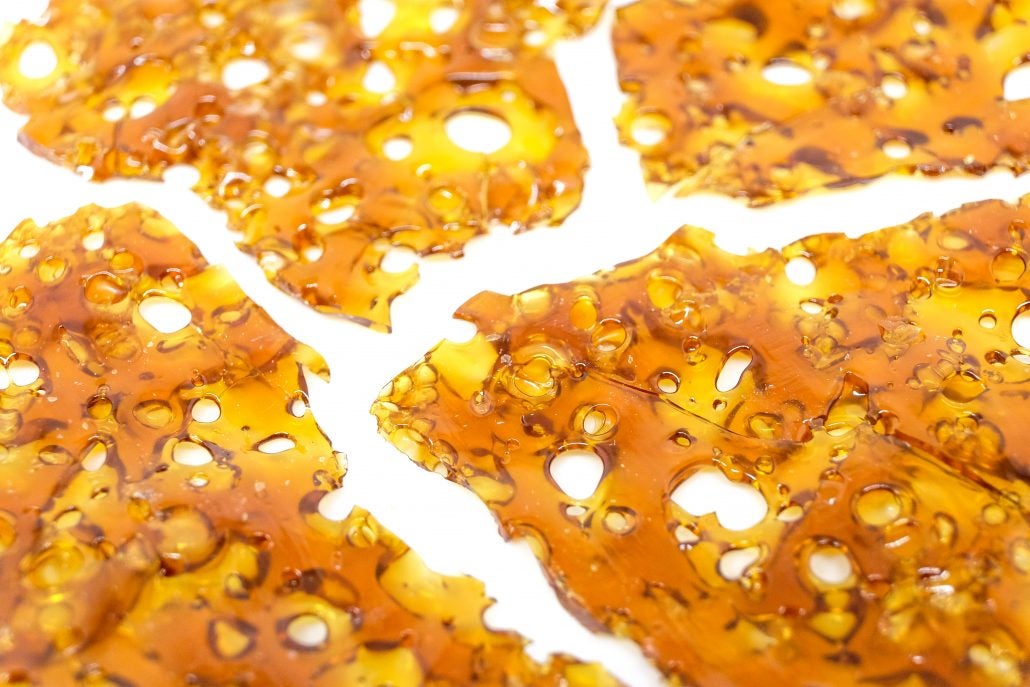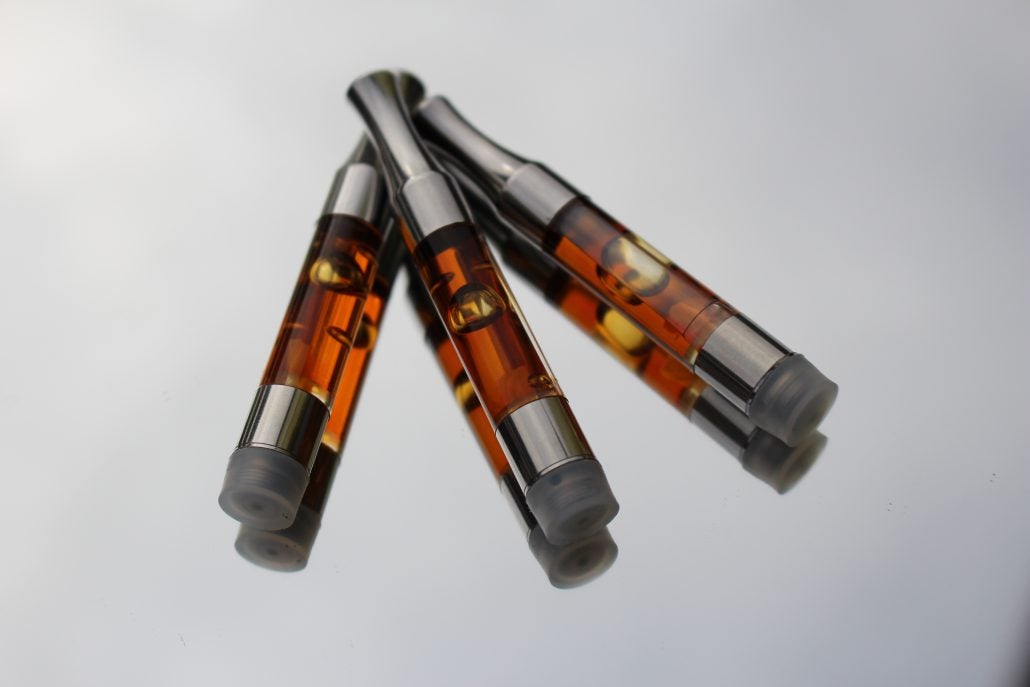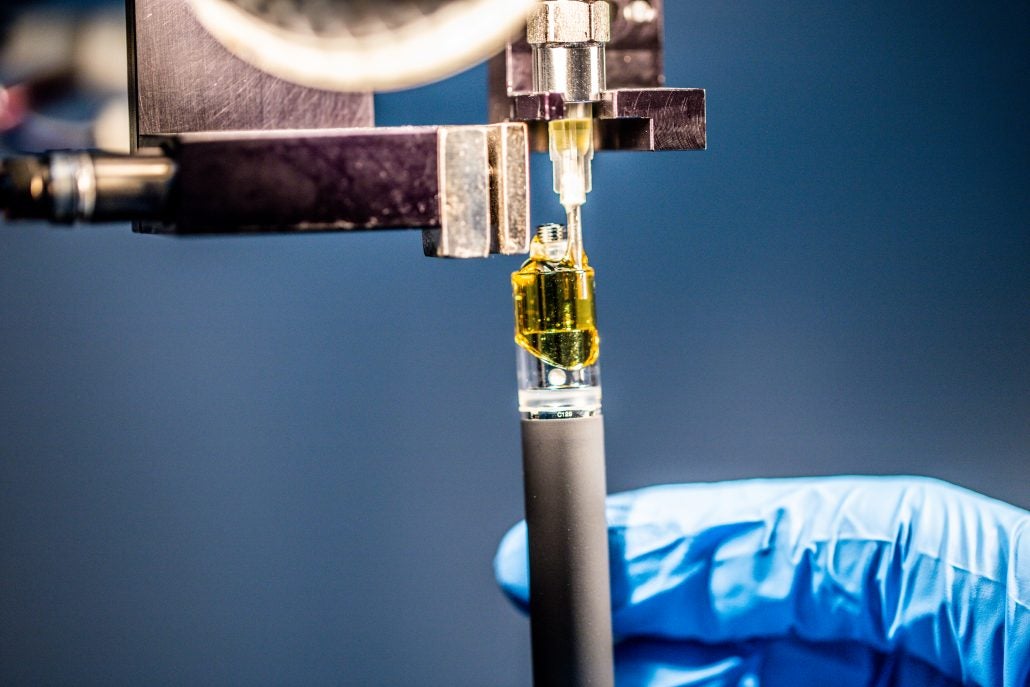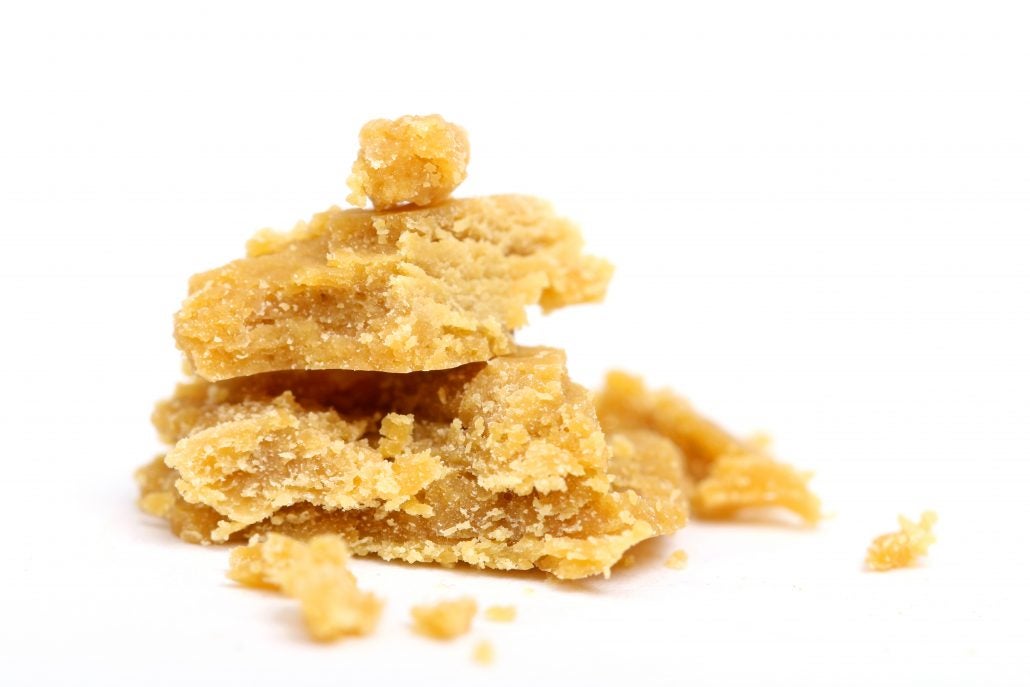Are you curious about cannabis concentrates but not sure where to start? We’ve come a long way since the days flower and hash dominated the landscape of cannabis products. Thanks to a desire for more versatile products and higher potency, cannabis concentrates have grown in popularity over the last decade. Today, there are various types of cannabis concentrates from which you can choose.
Knowing the different options available, how they are made, and how they are used is vital in helping you choose the right concentrates for you. Before getting into the different types available, we need to first look at what cannabis concentrates are.
What Are Cannabis Concentrates?
Cannabis concentrates contain only the desired compounds of the cannabis plant, which are targeted and extracted while leaving behind the excess plant material and other impurities. These desirable compounds are the terpenes and cannabinoids found in the small, hair-like structures known as trichomes. While the trichomes are the most densely concentrated on the buds, they are found all over the plant’s entire surface.
We can’t talk about concentrates without talking about extracts. Though some people use these two terms interchangeably, they do not refer to the same thing.
While all extracts are concentrates, not all concentrates are extracts.
The difference stems from the process used to make concentrates and extracts.
Creating extracts involves using solvents such as carbon dioxide or alcohol to wash the trichomes off the weed plant. Examples of such extracts include Rick Simpson Oil (RSO) and Butane Hash Oil (BHO).
For some concentrates, however, the manufacturing process employs physical or mechanical means to collect the trichomes. Kief and rosin are examples of concentrates made without solvents.
Depending on the extraction method used, concentrates come in different textures that allow you to experience them in various ways. Another benefit of concentrates is their high bioavailability, which helps your body absorb them quickly, allowing you to experience their effects faster.
Furthermore, the greater portion of terpenes and cannabinoids found in weed concentrates does wonders for the potency levels, although it varies between the different cannabis concentrates.
Types of Cannabis Concentrates
Cannabis concentrates come in a diverse range of options that make it possible for you to fine-tune your weed experience. You can easily find the combination that perfectly appeals to your tastes and preferences.
The variety and potency of concentrates can make using them a bit less straightforward. Fortunately, learning about the different types of cannabis concentrates and how they are created can help you find the best concentrates for you and how to consume them. We have purposely omitted hash, as it’s in a league of it’s own; we have an article dedicated to “How to Smoke Hash” here.
1. Shatter
Shatter is a clear cannabis extract with a texture that ranges from toffee-like to glass-like. However, in most cases, shatter attains a glass-like consistency, which is the inspiration behind its name.
To make shatter, hydrocarbons such as CO2 and butane pull the terpenes and cannabinoids from the cannabis plant. Once the process has extracted the compounds, manufacturers then take the solution through a second process known as vacuum oven purging. Here, they evaporate the solution to remove the solvent and any lingering moisture, resulting in a glass-like substance.
Shatter’s final texture and consistency might vary depending on the source plant’s terpene profile and what remains after extraction. It’s difficult to gauge the quality of shatter by merely looking at it. A clear or murky appearance doesn’t necessarily point to the amount of CBD and THC content.
Though shatter is known for its purity and often tests upwards of 80% THC, it contains lower terpene levels than other common concentrates.
So while shatter can pack a serious punch, it can lack in the flavour department.
If that’s an issue for you, there are concentrates that preserve the terpene profiles more effectively than shatter, such as live resin or sauce.

Thin, brittle shatter.
2. Budder
It sounds like butter, doesn’t it? That’s because this concentrate is named after its consistency, which resembles butter. Budder is actually one of the most sought-after options in the market today due to its high purity and potency. On average, budder has 99% purity and a 90% THC content.
This cannabis concentrate is, however, extremely difficult to manufacture because it requires continuous whipping during the vacuum oven purging stage. Its high potency, purity, and complicated manufacturing process are some of the reasons why budder is, unfortunately, very costly.
3. CO2 Oil
CO2 oil gets its name from the substance involved in extracting it— carbon dioxide, or CO2. Because it’s extracted with CO2 instead of butane or propane, CO2 oil is sometimes called “solvent-free”, although technically, CO2 was used as the solvent.
The first step in making CO2 oil is passing CO2 gas several times through a vessel containing cannabis. By controlling the temperature and pressure, the CO2 liquefies as it passes through the plant material, picking up terpenes and cannabinoids in the process, which are collected in a different container.
The extraction process produces some of the most high-quality types of concentrates on the market today. However, it’s also a costly process that requires the use of specialized equipment. Furthermore, the personnel in charge of extracting the concentrate need to be familiar with the various pressure and temperature settings required.

CO2 oil in a pre-filled cartridge.
4. Rosin
Rosin is exceptionally versatile because it can use kief, hash, or marijuana flower in its manufacture. It’s made through pressure and heat, which squeezes the sap from the cannabis plant material, resulting in a sappy, translucent, full-melt hash oil product.
Depending on the method, rosin can be a full or partial-spectrum extract. Full-spectrum extracts retain a cannabis plant’s complete profile and often contain a variety of terpenes, cannabinoids, and other compounds.
Many concentrates are not full-spectrum because the extraction processes filter some of the plant compounds during the refinement process.
If manufacturers carry out the extraction process the right way, rosin can attain the level of potency that rivals other cannabis concentrates.
5. Live Resin
With live resin, its name doesn’t come from its appearance or extraction process, but from the plant material used. While most concentrates come from dried and cured cannabis plant material, live resin uses fresh plants that are flash-frozen at its peak potency.
Farmers harvest and flash-freeze the cannabis plants to lock in the volatile cannabinoids and terpenes that sometimes get lost during the curing process. The temperature for extracting live resin also differs from that necessary to extract other cannabis concentrates.
Thanks to light hydrocarbons, super-cold temperatures are possible for extracting the live resin, thus preserving the most volatile cannabinoids within the final product. Despite the differences in manufacturing processes, live resins still have high terpene content and are classified as HTFSE (High Terpene Full Spectrum Extracts).

Live resin is popular for its flavour and potency.
6. Sauce
Also known as terp sauce, sauce is a cannabis extract with a fluid consistency that’s all about the flavour.
Terpenes are volatile and can degrade quickly, even when exposed to normal temperatures. The main goal of the sauce extraction process is to maintaining the original terpene profile, which happens with lower temperatures and a lighter solvent, such as one with a dominant propane blend. Using fresh, flash-frozen cannabis plants and primitively temperature adjustments, manufacturers extract terpene sauce from cannabinoids diamonds.
Sometimes crystalline structures will spontaneously form in terp sauce. Known as ‘diamonds’, these crystals are made out of THCA (a precursor to THC).
7. Honey Oil
This is a full-spectrum oil which has the consistency of honey (hence “honey oil”). It is made by blasting dried flower with butane, collecting the run-off, and evaporating the solvent (butane) to leave behind a full-spectrum oil. Honey oil has many uses, but can mainly be consumed in the same fashion as other concentrates; through dabbing, smoking in a pipe or putting in a joint.
How to Use Concentrates
People use cannabis concentrates in various ways, ranging from adding them to a blunt to reinforce potency, to vaporizing them using a vape pen or a dab rig. The method you go for depends on your preferences and the type of concentrate you are using. Here are some of the common ways of consuming concentrates:
Topping Your Weed
People add some concentrates, such as wax or powdered kief, to their joint or bowl. This consumption method is the most cost-effective option because it doesn’t require the extra equipment needed of other consumption methods like dabbing.
Besides being a money-saver, topping your weed will also increase the high you can enjoy from your blunt by adding the concentrate’s flavour to your smoke. A downside, though, is that you will not be able to experience the full potency of your concentrate, and you’ll lose out on the delicate terpenes, too.
Vaping
Vaping is the most portable and discreet option used for consuming concentrates. This method will require a bit more investment than topping your weed because of the expense of purchasing and maintaining the vaporizer and a supply of the THC or CBD concentrate-filled vape cartridges.
However, you will get to enjoy any concentrate on the go, benefiting from higher levels of potency than those achieved when you top up your flower.
Vaporizers come in different shapes and sizes, with some of the common options including pre-filled and refillable vaporizers.
Pre-filled Vaporizers
These types of vaporizers contain a mouthpiece and a cartridge pre-filled with the concentrate of your choice. The cartridge has an element that heats the concentrate when it is in contact with the battery, and all you need to do is activate it.
Most vape pens have a button that you press to activate the heating element, while others are buttonless and only need you to inhale from the mouthpiece to activate them.
If you can unscrew the battery from the cartridge, you’ll be able to replace the empty cartridge with a new one (like HVE carts) and keep using the battery. Other pre-filled vapes are disposable, which means you will have to discard the entire thing— battery, catridge and all— once the battery dies or you empty the catridge.
Refillable Vape Carts
Refillable vape cartridges allow you to manually fill your vape pen’s chamber with the concentrate of your choice. While they can often look similar to the prefilled vape cartridges, the big difference is that refillable carts allow you to unscrew the mouthpiece to refill it.

Vape cartridge being filled by the manufacturer.
Dabbing
You need to have the right equipment and set-up to effectively smoke concentrates by properly activating the potency of the concentrated terpenes and cannabinoids. Dabbing is the best way to do that and is one reason why it’s the most popular method of consuming cannabis concentrates.
This method involves the use of a ‘dab rig’ to vaporize the concentrate. The rig contains a nail made from titanium, glass, or ceramic. You expose the nail to heat for a pre-determined period or until it attains a red- or orange-hot glow. Once it does, you apply the concentrate directly onto the nail’s hot surface, immediately turning it into the vapour that you then consume.
There are a few factors to keep in mind when building your ideal dab rig. One major factor is the material to use for your rig’s nail. Some opt to dab weed concentrates on a quartz nail because it heats up faster than titanium and also offers a cleaner taste.
On the other hand, titanium nails are more durable than quartz. Ultimately, the choice you go for is entirely down to your preferences and desires.
Concentrate Textures
The different extraction steps determine not only the final concentrate products but also the kind of texture the products will have. Common textures include shatter, badder and budder, crumble, crystalline, and distillate.
Shatter
Shatter is a versatile texture that often resembles brittle glass and, in some cases, a snap-and-pull texture, elastic-like texture. Shatter manufacture uses various solvent extraction methods, with CO2, propane, and butane as the most popular options.
Badder and Budder
The textures of badder and budder result from agitating the terpene-rich shatter to make it attain a more creamy texture. The manufacturer whips the shatter under low temperatures to introduce and evenly redistribute air molecules. The volume of air molecules determines the resulting texture’s density.
Crumble
For a cannabis concentrate to attain a crumble texture, it goes through the shatter and badder and budder stages, then a vacuum oven purge at low temperatures. This dries the concentrate while ensuring that it retains its terpene and cannabinoid content.

That’s the way this concentrate crumbles.
Crystalline
While there are several methods you can use to make a cannabis concentrate with a crystalline texture, they all employ the same crystallization principles.
You mix a chemical solid and liquid to form an initial solution that then goes through additional steps to remove any impurities. After, you mix the extract with a different solvent under a different set of conditions that lead to the formation of pure crystals and the final crystalline product.
Distillate
You create distillates by exposing a decarboxylated and winterized cannabis extract to heat and vacuum. This leads to the separation of cannabinoids, depending on their different boiling points.
Making Cannabis Concentrates
Essentially, making cannabis concentrates employs two primary methods: physical separation and liquid solvent separation.
Physical Separation
With physical separation, means such as pressing or shaking extract the trichome glands from the plant. An example of a concentrate extracted using physical separation is dry sift. With dry sift, you would shake the cannabis through various screens with specific sizes, ensuring that only the trichome heads sift through. Rosin is another concentrate made via physical separation.
Liquid Solvent Extraction
While liquid solvent extractions might differ depending on the solvent, this method employs the same basic steps. A solvent separates the desired compounds from trichome glands, forming a solution in the process that then goes through refinement to attain only the desired compounds.
Refining the solution is often done by placing it into a vacuum oven, ensuring the complete removal of the solvent and excess moisture.
Because most of the common solvents are often volatile, technicians use a closed-loop extraction system. This allows them to safely control elements such as pressure and temperature and achieve the optimal results needed for the extraction process. To learn more about the different cannabis extraction processes, click here.
Conclusion
The types of cannabis concentrates listed here are by no means the only concentrates available in the market. These are, however, a few of the most popular options and, if you are new, are great ways to introduce yourself to the world of concentrates.
As consumers’ tastes evolve and the advancements made in technology enable more sensitive extraction possibilities, concentrates will continue improving. Already, the extraction has shifted from a focus on THC to terpene-forward products.
This shift has created a more versatile market that can equally satisfy the consumers who desire high potency and those interested in their concentrate’s flavour profile.
If the last few years are anything to go by, then we are steadily moving to an even more exciting cannabis concentrate future, and Budmail will be right at the cusp of the latest developments.
Shop with us today and get access to our extensive catalogue of the best concentrates in Canada. These options include:
- Rosin (royalty rosin)
- Craft rosin
- Live rosin (Jungle Ridge)
- Sauce
- Shatter (Cosmic Concentrates)
- Honey oil
- CO2 oil
- Live resin (high voltage extracts)
- Budder (Lucky Extracts)
- Cherry oil
- Phoenix tears
Whatever cannabis concentrate you prefer, head on over to our website, purchase as much as you desire, and we’ll deliver it straight to you.
